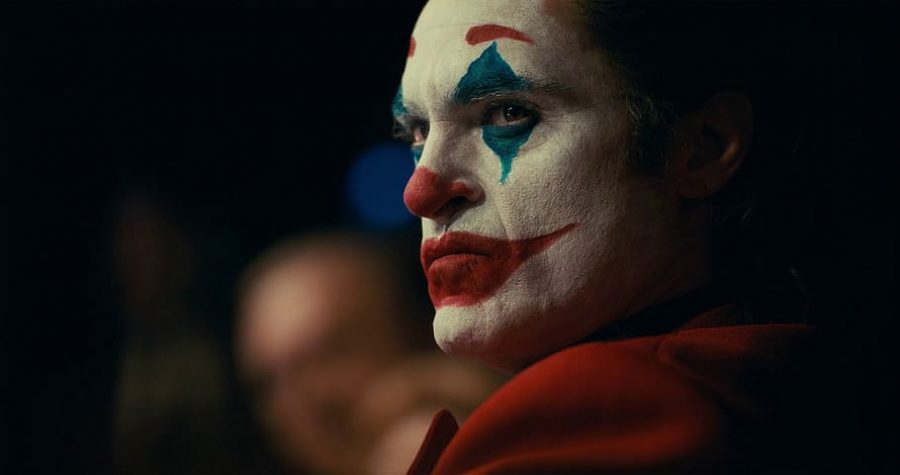Looking back on “Joker”
January 17, 2020
After the last couple of weeks, Todd Phillips and Joaquin Phoenix are undoubtedly very happy men. On Jan. 5, Phillips’ film “Joker,” which stars Phoenix as the titular character, won two of the four Golden Globe awards it was nominated for. Following that, on Jan. 13, the film also received 11 Oscar nominations.
The Joker’s face—his white skin, red lips, green hair and wide smile—has become an extremely iconic image, searing itself into the minds of superhero fans everywhere.
To create his face, Phoenix’s Joker applies his own makeup in the film. This lends a human quality to his portrayal of the character. He is not just a madman, he is a human who has to put on the face of a clown.
In fact, the audience sees Phoenix without his makeup for the majority of the film, which is not typical for portrayals of the Joker, conveying a humanity not usually displayed. Additionally, Phoenix’s Joker has a name: Arthur Fleck.
Before he becomes the Joker, Fleck is a mentally ill clown, bullied by society as he tries to live out his dream of becoming a comedian. Phoenix’s Joker has his humanity on full display for the audience to see, allowing them to trace how he loses it and becomes the Clown Prince of Crime. The audience sees exactly how Phoenix’s Arthur Fleck becomes the Joker: society pushes him to his breaking point, and the only thing he feels like he can do is punish that society.
In the film’s opening scene, the audience sees Fleck in the process of applying his clown makeup, showing them that Phoenix’s Joker starts his journey as a human. Fleck is alone, looking in the mirror as he turns himself into a clown. The room is dark, but the mirror is framed by lights.
Later in the film, the audience learns that Fleck just wants to be noticed and recognized by the world around him. He wants to see himself in lights. At the end of the scene, a tear streams down Fleck’s face as he tries to force himself to smile.
Fleck desperately wants to be happy. He wants to make people laugh. He says that his mother told him he was “born to bring joy and laughter into the world.” And yet, he can’t even bring himself happiness or joy.
Phoenix’s portrayal of the Joker is extremely humanizing and sympathetic. The film is an in-depth character study that, through its depiction of Fleck’s journey into madness and into the identity of the Joker, leaves the audience in a sort of limbo.
Some critics claim that this has the effect of making the Joker a sympathetic, victim-like character, even though he is traditionally portrayed as a homicidal maniac. Part of this is most certainly due to the prevalence of his actual face in the movie. Such sympathy is dangerous, as it tempts the audience to feel for and root for a murderous character.
Phoenix’s Joker is the protagonist and center of Phillips’ film. He is also a murderer, which makes him an unconventional protagonist. Now, directors and writers should experiment with their stories; however, Phillips and Phoenix created a character that is too easy to root for, which is not what the Joker should be.
Fleck is, without a doubt, a victim for much of the film. He is beaten, abused, lied to and shunned by anyone and everyone around him. His medical condition, which causes him to break out in uncontrollable bursts of laughter, is not his fault, and yet he is punished for it. None of his medication is doing anything to help his mental health, and worse, the program providing the medicine has its funding cut. The social worker he sees could not really care less about him. The audience cannot help themselves but to feel bad for him and want him to win.
However, the sympathy that the film evokes becomes a problem when Fleck kills three men on the subway (two in self-defense and one out of revenge) and crosses the line from victim into villain. This is when Fleck starts to become the Joker.
After he kills the three men, he runs into an abandoned public restroom. At first, he is frantic and anxious, slamming the door behind him as he breathes heavily. Then, that fades away and is replaced by a feeling of ease, and he dances right there in the bathroom.
Later, he conjures a school shooter character when he spares someone’s life, telling him “You were always nice to me.” This line evokes the idea that, occasionally, a school shooter may spare a student who was kind to them. And yet, the film continues to portray him as a sort of hero.
That is the film’s biggest problem. After working so hard to create a character the audience can feel sympathy for, Phillips and Phoenix make that character a glorified murderer. Phoenix’s Joker is a man suffering from severe mental illness and the harshness of the world around him until he finally snaps. But, the film portrays the Joker’s snap as somewhat heroic, as if the audience is meant to celebrate the Joker.
Film reviewer A.A. Dowd, writer for the AV Club, has similar sentiments about Phillips’ film. Dowd writes that “‘Joker’ … is very much a story of self-actualization through violence … by adopting the perspective of its budding killer, ‘Joker’ risks making his rise to notoriety look triumphant—like a rebirth, the outcast getting over on a world that’s abused and neglected him.” The movie toes the line of making Fleck look too good and making the audience root for him too much. Fleck ends the movie victorious: he has become who he was meant to be, he has a huge mob supporting him and all of his rivals are dead. Fleck is placed in a mental hospital, Arkham State Hospital, but it appears that he will escape. Fleck achieves self-actualization and public recognition.
Dowd thinks this is what makes the film problematic. Self-actualization, becoming who you are meant to be, is a goal for many people’s lives, and by portraying Fleck’s transformation into the Joker as a self-actualization process, the movie edges dangerously close to idolizing his murderous actions.
America is in the midst of a mental health crisis. With a culture of school and mass shootings, the need for mental health care reform is more obvious than ever. Phillips told a story to reflect that. Unfortunately, Phillips got lost along the way and risked creating a dangerous work of art.
The Joker is a powerful and influential character. That was true when he was created in the 1940s and it is still true today in 2020. However, it may be time to retire the character, at least for a while.
Portrayals of mentally ill individuals as violent can be harmful. The overwhelming majority of people who suffer from mental illness are not violent and will never become violent. Stories of villains like the Joker are wildly misrepresentative of the reality of mental illness. We do not need to validate such stories by giving this movie the most prestigious awards in filmmaking.



